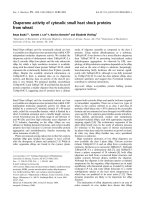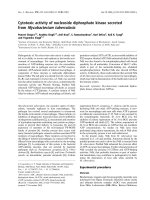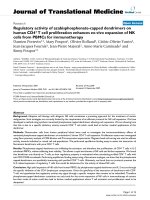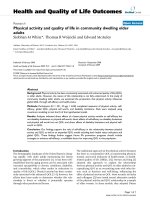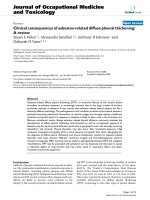báo cáo hóa học: " Photo-catalytic activity of Zn1-xMnxS nanocrystals synthesized by wet chemical technique" ppt
Bạn đang xem bản rút gọn của tài liệu. Xem và tải ngay bản đầy đủ của tài liệu tại đây (538.39 KB, 5 trang )
NANO EXPRESS Open Access
Photo-catalytic activity of Zn
1-x
Mn
x
S nanocrystals
synthesized by wet chemical technique
Mansi Chitkara
1
, Karamjit Singh
2*
, Inderjeet Singh Sandhu
1
and Harbhajan Singh Bhatti
2
Abstract
Polyvinyl pyrrolidone capped Zn
1-x
Mn
x
S(0≤ x ≤ 0.1) nanocrystals have been synthesized using wet chemical co-
precipitation method. Crystallographic and morphological characterization of the synthesized materials have been
done using X-ray diffraction and transmission electron microscope. Crystallographic studies show the zinc blende
crystals having average crystallite size approx. 3 nm, which is almost similar to the average particle size calculated
from electron micrographs. Atomic absorption spectrometer has been used for qualitative and quantitative analysis
of synth esized nanomaterials. Photo-catalytic activity has been studied using methylene blue dye as a test
contaminant. Energy resolved luminescence spectra have been recorded for the detailed description of radiative
and non-radiative recombination mechanisms. Photo-catalytic activity dependence on dopant concentration and
luminescence quantum yield has been studied in detail.
Introduction
Environmental pollution, toxic water pollutants, and
industrialization on a global scale have drawn attention
for sustained fundamental and applied research in the
area of environmental remediation. The increased public
concern with environmental pollutants has prompted
the need to develop novel treatment methods [1] where
photo-catalysis is gaining a lot of attention in the field
of pollutant degra dation. Semiconductor photo-catalysts
offer the potential for complete elimination of toxic che-
micals through their efficiency and potentially broad
applicability [2,3]. Recent ly, semiconduct or nanocryst als
have attracted great attention due to their size tunable
physical and chemical properties. Transition from bulk
to nanoparticles lead to the display of quantum mechan-
ical properties and an increased dominance of surface
atoms, which give rise to unique photo-physical and
photo-catalytic properties of nanomaterials, for example,
with the decrease of particle size, extremely high surface
to volume ratio is obtained leading to an increase in
surface specific active sites for chemical reactions and
photon absorption to enhance the reaction and absorp-
tion efficiency. The enhanced surface to volume ratio
causes increase of surface states, which changes the
activity of electrons and holes, affecting the chemical
reaction dynamics. The size quantization increases the
bandgap of photo-catalysts to enhance the redox poten-
tial of conduction band electrons and valence band
holes [4].
Various new compounds and materials for photo-cata-
lysis have been synthesized in the past few decades
[5-13]. Semiconductor photo-catalysts, with a primary
focus on TiO
2
[14-17], have been applied to variety of
problems of environmental interest in addition to water
and air purification. The application of illuminated
semiconductors for degrading undesirable organics dis-
solved in air or water is well documented and has been
successful for a wide variety of compounds [2]. Transi-
tion-metal sulphides, in particular ZnS [18,19], have
unique catalytic functions as a result of the rapid gen-
eration of electron-hol e pairs by photo-excitation and
the hig hly negative reduction potentials of excited elec-
trons. Moreover, incorporation of metal ion dopants in
these semiconductor nanoparticles can influence their
photo-catalytic performance. Doping of Mn
2+
ions in
ZnS lengthens the lifetime of generated charge carriers,
resulting in an enhancement in the photo-activity.
Hence, ZnS:Mn
2+
nanocrystals can be efficiently used
for environmental cleaning, H
2
production, and water
purification. This arti cle reports pho to-c ataly tic activity
of Zn
1-x
Mn
x
S nanocrystals. Photo-catalytic activity has
been well correlated with the luminescence quantum
yield. Moreover, photo-catalytic and luminescence
* Correspondence:
2
Department of Physics, Punjabi University, Patiala, Punjab 147 002, India
Full list of author information is available at the end of the article
Chitkara et al. Nanoscale Research Letters 2011, 6:438
/>© 2011 Chitkara et al; licensee Springer. This is an Open Access article distributed under the t erms of the Creative Commons
Attribution License (http://creativecomm ons.org/licenses/b y/2.0), which permits unr estricted use, distribution, and rep roduction in
any medium, provided the original work is properly ci ted.
efficiency dependence on the Mn
2+
concentration have
been described in detail.
Experimental
Zn
1-x
Mn
x
S(0≤ x ≤ 0.1) nanocrystals have been synthe-
sized using wet chemical co-precipitation method
already opted by Singh et al. [20] for the synthesis of
Eu
3+
doped Cd
1-x
Zn
x
S qua ntum dots. All synthesis was
carried out at room temperature under ambient condi-
tions in aqueous media for its inherent advantages o f
being simple and environmental friendly. Analytical
reagent grade chemicals: zinc acetate (C
4
H
6
O
4
Zn ·
2H
2
O), manganese acetate (C
4
H
6
MnO
4
·4H
2
O), sodium
sulphide (Na
2
S·H
2
O), and polyvinyl pyrrolidone (PVP)
[(C
6
H
9
NO)
n
] were used without further p urification.
Solutions of 0.5 M zinc acetate, 0.5 M sodium sulphide,
and 1 M manganese acetate w ere prepared in separate
beakers. Then zinc and manganese precursor solutions
were mixed in the stoichiometric proportion under vig-
orous stirring, 4 ml of 2% PVP solution was added to
total 50 ml volume, before drop wise addition of sulfur
precursor. PVP will act as the capping agent to avoid
the agglomeration of nanocrystals. The resulting precipi-
tates were centrifuged and dried in vacuum oven for 10
to 12 h continuously.
Panalytical’s(Netherlands)X’Pert Pro Powder X-ray
diffractometer with Cu K
a
radiation (l = 1.541 Å) was
used to record diffraction patterns of the synthesized
samples in the 2 θ range 20 to 60°. Average crystallite
size has been calculated from the line broadening of t he
X-ray diffraction (XRD) diffractogram using Scherrer
formula [21]. Hitachi, [(H-7500), Japan] transmission
electron microscope (TEM) was used to record micro-
graphs for average partic le size determination. For TEM
studies, a drop of well ultrasonicated ethanol dispersed
nanocrystals was placed on the carbon coated copper
grid.
Atomic absorption spectrometer (Analytic Jena, Ger-
many) has been used for qualitative and quantitative
analysis of the synthesized nanomaterials. Sample pre-
paratio n for the analysis involves disso lution of 0.01 mg
of nanocrystals in 10 ml of 0.5% HNO
3
.
Energy resolved luminescen ce spectra w ere recorded
using FlouroMax-3 (Jobin-Yvon, Edison, NJ, USA) spec-
trofluorometer equipped with photo multiplier tube and
a xenon lamp.
The ph oto-catalytic activity of Zn
1-x
Mn
x
S nanocrystals
was studied by monitoring the degradation of methylene
blue (MB) (C
16
H
18
ClN
3
S·2H
2
O) dye in an aqueous
suspension containing Zn
1-x
Mn
x
S nanocrystals under
the UV-radiation exposure with continuous magnetic
stirring. A 350 ml of aqueous suspension was prepared
by completely dissolving 1.1322 mg of the MB dye and
then dispersing 140 mg of the Zn
1-x
Mn
x
Snanocrystals
in the de-ionized water. The resulting suspension was
equilibrated by stirring in the dark for 1 h to stabilize
the adsorption of MB dye on the surface of nanocrystals.
The stable aqueous suspension was then exposed to the
UV-radiation with continuous magnetic stirring, usi ng
the home made photoreactor containing two 18-W
tubes as the UV-source (l = 200 to 400 nm). Following
the UV-radiation exposure, 10 ml sample of aqueous
suspension was taken out after every 10-min interval for
the tot al 80 min of the UV-radiation exposure. Suspen-
sion sample was centrifuged to filter out the Zn
1-x
Mn
x
S
nanocrystals, then nanocrystal free aqueous dye solution
was examined using UV-vis absorption spectrophot-
ometer (Systronics PC Based Double Beam Spectrophot-
ometer:2202) to study the photo-degradati on of the MB
dye.
Results and discussion
Broad XRD patterns have been recorded for all the
synthesized Zn
1-x
Mn
x
S samples, Figure 1 shows one
such X-ray diffractogram recorded for Zn
0.9900
Mn
0.0100
S.
It is clear from the diffractogram that synthesized sam-
ples crystallize in zinc blende structure with the planes
at {111}, {220}, and {311}, respectively. Recorded diffrac-
tion peaks are broadened due to the nanocrystalline nat-
ure of particles. Average crystallite size calculated from
the recorded XRD patterns is approx. 3 nm.
Figure 2 shows the TEM micrograph recorded for
Zn
1-x
Mn
x
S nanocrystals. Average particle size cal culated
from micrograph is approx. 3 to 4 nm, which is i n
proximity to the average crysta llite size determined by
XRD. So, all the synthesized particles are single
nanocrystals.
Atomic absorption spectrometer (AAS) studies show
that the actual concentration of manganese doping is
approx. 24% of th e initial manganese precursor conc en-
tration, which was added to the reaction media. So, the
value of x in Zn
1-x
Mn
x
S corresponds to initial atomic
Figure 1 XRD pattern of Zn
0.9900
Mn
0.0100
S nanocrystals.
Chitkara et al. Nanoscale Research Letters 2011, 6:438
/>Page 2 of 5
weight concentration of manganese with respect to zinc,
which was calculated during stochio metric addition of
precursors in the chemical co-precipitation reaction.
Figure 3 shows absorption spectra of synthesized nano-
crystals, which lie in UV range. Energy resolved lumines-
cence spectra shown in Figure 4 have been recorded at
room temperature using 325-nm excitation. It is clear
from the recorded spectrum that pure Z nS nanocrystal s
show only 425-nm emission peak, whereas dichromatic
emission (l
1
= 425 nm and l
2
= 599 nm) has been
observed in case of Mn
2+
-doped ZnS nanocrystals. Lumi-
nescence quantum yield of l
2
emission peak go on
increasing with the increase of ‘x’ in Zn
1-x
Mn
x
Snano-
crystals, whereas l
1
emission intensity go on decreasing
with increasing concentration of Mn
2+
ions. More than
six-fold increase and two-fold decrease has been
observed in the emission intensities of l
2
and l
1
peaks,
respectively, when the value of ‘x’ changes from 0.01 to
0.1 in Zn
1-x
Mn
x
S nanocrystals. The Mn
2+
ions substitute
the Zn
2+
ions in the ZnS na nocrystal acting as trap sites
[22], where the electrons and holes can be trapped. Elec-
trons after photo-excitation process in the host lattice
subsequently decay via non-radiative process to the
4
T
1
localized state of manganese. The l
2
(599 nm) emission
peak is attributed to the radiative decay between the
4
T
1
and
6
A
1
localized states of manganese inside the ZnS
bandgap. The l
1
emission (425 nm) peak is assigned to
the radiative transition of electrons from shallow trap
states (ST) near the conduction band to sulfur vacancies
(V
s
) residing near the valence band. The increasing
dopant concentration quenches the host related 425 nm
emission. Detailed mechanism of various processes
involved in Zn
1-x
Mn
x
S nanocrystals upon excitatio n is
shown in Figure 5. Photo-excited electrons from the con-
duction band transit spontaneously to the ST and
4
T
1
manganese trap sites via non-radiative processes. These
ST electrons can recombine radiatively with V
s
holes or
further relaxed non-radiatively to the localized dopant
trapping states. Radiative recombination of ST electrons
and V
s
holes is faster than the radiative transition
between the
4
T
1
and
6
A
1
localized states [23].
Figure 6 shows absorption spectra of pure MB dye with
and without UV radiation exposure. It can be clearly seen
from the recorded spectra that both the c urves overlap
on each other, which confirms that there is no photo-
bleaching of pure MB dye.
Figure 7 shows the Zn
1-x
Mn
x
S(0≤ x ≤ 0.1) nanocrystals
sensitized photo-degradation of MB dye under UV-radia-
tion exposure. It can be clearly seen that MB dye is
degraded to maximum extent in case of Zn
0.9900
Mn
0.0100
S
nanocrystals, whereas it is degraded to minimum extent
for Zn
0.9000
Mn
0.1000
S nanophoto-catalyst. Photoredox
chemistry occurring at nanocrystal surface emanates from
Figure 2 TEM image of Zn
1-x
Mn
x
S nanocrystals.
Figure 3 Absorption spectra of nanocrystals.
Figure 4 Photoluminescence spectra of Zn
1-x
Mn
x
S nanocrystals.
Chitkara et al. Nanoscale Research Letters 2011, 6:438
/>Page 3 of 5
trapped charge carriers. Incorporation of Mn
2+
in ZnS
nanocrystal lattice significantly influences the photo-cataly-
tic activity. Addition of Mn
2+
ions lengthens the lifetime of
excited charge carriers, which results the enhanced photo-
catalytic activity. Various charge carrier recombination and
charge carrier trapping processes are shown in Figure 5.
The competition between the charge carrier re combination
and charge carrier trapping followed by the competition
between recombination of trapped carriers and interfacial
charge transfer deter mine the overall quantum efficiency
for interfacial charge transfer. Doping of Mn
2+
up to opti-
mal concentration increases the interfacial charge transfer
probability, due to which photo-catalytic activity of ZnS
nanocrystals is enhanced. As shown in Figure 7, photo-cat-
alytic activity enhances with increasing value of ‘x’ only in
the range x =0tox = 0.01, further increase of dopant con-
centration, i.e., x = 0.01 to x = 0.1 deteriorates photo-cata-
lytic activity o f Zn
1-x
Mn
x
S nanocrystals. It is due to the fact
that up to op timal Mn
2+
concentration (x = 0.01), Mn
2+
ions lengthens the charge carrier recombination, but at
higher dopant concentrations although the possibility of
charge carrier trapping is high, but the charge carriers may
recombine t hrough quantum tunneling. Moreover, i ncreas-
ing concentration of Mn
2+
ions may cause the increased
interaction between neighboring Zn
2+
ions and the Mn
2+
luminescence centre that enhances the spin-orbit coupling
of Mn
2+
ions, which leads to the relaxation of the s pin
selection rules [24]. This lowers the radiative recombina-
tion time for
4
T
1
®
6
A
1
transitions, so the recombination
of trapped carriers dominates interfacial charge transfer at
the higher dopant concentrations. Due to enhanced recom-
bination rate luminesce nce quantum yield increases to
large extent as shown in Figure 4. Figure 8 shows the
absorption spectrum of MB dye solution for different dura-
tions of UV-radiation exposure in the presence of
Zn
0.9900
Mn
0.0100
S nanocrystals (optimal dopant concentra-
tion). Zn
0.9900
Mn
0.0100
S nanocrystal photo-catalyst is effi-
ciently degrading the dye, only negligible amount of dye is
present in the solution after 80 min. There is a concentra-
tion dependent slight spectral shift in MB dye absorption
spectra as the UV irradiation time changes from 0 to 80
min. Red shift in the absorption peak with increasing dye
concentration has been observed due to augmented optical
density. Moreover, at higher concentrations, aggregation
can take place, which affects the optical behaviour. These
non-toxic, stable, inexpensive nanocrystalline photo-cata-
lyst having high-redox potentials can be efficiently used for
environmental c leaning, water p urification, and H
2
produc-
tion. Moreover, due to non-dissolving nature in aqueous
Figure 5 Processes involved in Zn
1-x
Mn
x
S nanocrystals upon
excitation. CB, conduction band; ST, shallow trap;
4
T
1
and
6
A
1
,
manganese levels; VB, valence band; V
s
, sulfur vacancy.
Figure 6 Absorption spectra of pure MB dye.
Figure 7 Photodegradation of MB dye with time.
Figure 8 Absorption spectrum of dye solution for different
durations of UV-radiation exposure in the presence of
Zn
0.9900
Mn
0.0100
S nanocrystals.
Chitkara et al. Nanoscale Research Letters 2011, 6:438
/>Page 4 of 5
media, these photo-catalysts can be easily recovered after
use.
Conclusions
Zn
1-x
Mn
x
S(0≤ x ≤ 0.1) nanocrystals have been success-
fully synthesized in aqueous media using a simple wet che-
mical precipitation technique. Crystallographic and
morphological studies reveal the zinc blende nanostruc-
tures having average crystallite size approx. 3 nm. Energy
resolved luminescence spectra report the quenching of
host-related 425 nm emission and enhancement in lumi-
nescence quantum yield of dopant-related 599 nm emis-
sion, with the increasing concentration of Mn
2+
ions.
Photo-catalytic activity of nanocrystals studied using MB
dye as a test contaminant enhances with the addition of
Mn
2+
ions in ZnS nanocrystals upto to optimal concentra-
tion (1 at. wt% of Zn
2+
), but the further increase of dopant
concentration deteriorates photo-catalytic activity of Zn
1-
x
Mn
x
S nanocrystal s as the recombination of trapped car-
riers dominates the interfacial charge transfer at the higher
dopant concentrations. This mechanistic information of
photo-catalytic activity dependence on dopant concentra-
tion and luminescence quantum yield will significantly
contribute to enhance the understanding of photo-
initiated processes in semiconductor nanocrystals.
Abbreviations
AAS: atomic absorption spectrometer; CB: conduction band; MB: methylene
blue; PVP: polyvinyl pyrrolidone; ST: shallow trap; TEM: transmission electron
microscope; VB: valence band; XRD: X-ray diffraction.
Acknowledgements
Authors express their gratitude to Dr. Shyam Kumar, Chairman, Department
of Physics, Kurukshetra University, Kurukshetra and Dr. Sanjiv Aggarwal,
Reader, Department of Physics, Kurukshetra University, Kurukshetra for
energy resolved spectroscopic studies. Regional Scientific Instruments Centre
(RSIC), Punjab University, Chandigarh is gratefully acknowledged for
crystallographic and morphological studies.
Author details
1
Nanomaterials Research Laboratory (NRL), Department of Applied Sciences,
Chitkara University, Rajpura, Punjab 140 401, India
2
Department of Physics,
Punjabi University, Patiala, Punjab 147 002, India
Authors’ contributions
MC: Performed experimental work. KS: Generated scientific idea, performed
experimental work with first author and written the manuscript. ISS:
Supported and participated in the technical work. HSB: Steer for generation
of scientific idea and manuscript design.
Competing interests
The authors declare that they have no competing interests.
Received: 23 April 2010 Accepted: 24 June 2011
Published: 24 June 2011
References
1. Zeltner WA, Anderson MA: The use of nanoparticles in environmental
applications. In Fine Particles Science and Technology. Edited by: Pelizzetti E.
Dordrecht: Kluwer Academic Publishers; 1996:643.
2. Hoffmann MR, Martin ST, Choi W, Bahnemann DW: Environmental
applications of semiconductor photocatalysis. Chem Rev 1995, 95:69.
3. Anpo M, Takeuchi M: The design and development of highly reactive
titanium oxide photocatalysts operating under visible light irradiation. J
Catal 2003, 216:505.
4. Hoffmann AJ, Mills G, Yee H, Hoffmann MR: Q-sized cadmium sulphide:
synthesis, characterization and efficiency of photoinitation of
polymerization of several vinyl monomers. J Phys Chem 1992, 96:5546.
5. Anpo M, Shima T, Kodama S, Kubokawa Y: Photocatalytic hydrogenation
of CH
3
CCH with H
2
O on small particle TiO
2
: Size quantization effects
and reaction intermediates. J Phys Chem 1987, 91:4305.
6. Choi W, Termin A, Hoffmann MR: The role of metal ion dopants in
quantum sized TiO
2
: correlation between photoreactivity and charge
carrier recombination dynamics. J Phys Chem 1994, 98:13669.
7. Kanemoto M, Hosokawa H, Wada Y, Murakoshi K, Yanagida S, Sakata T,
Mori H, Ishikawa M, Kobayashi H: Semiconductor photocatalysis. Part 20-
Role of surface in the photoreduction of carbon dioxide catalysed by
colloidal ZnS nanocrystallites in organic solvent. J Chem Soc Faraday
Trans 1996, 92:2401.
8. Claudia L, Martinez T, Kho R, Mian OI, Mehra RK: Efficient photocatalytic
degradation of environmental pollutants with mass-produed ZnS
nanocrystals. J Colloid Interface Sci 2001, 240:525.
9. Hu JS, Ren LL, Guo TG, Liang HP, Cao AM, Wan LJ, Bai CL: Mass production
and high photocatalytic activity of ZnS nanoporous nanoparticles.
Angew Chem Int Ed 2005, 44:1269.
10. Janet CM, Viswanath RP: Large scale synthesis of CdS nanorods and its
utilization in photo-catalytic H
2
production. Nanotechnology 2006,
17:5271.
11. Zheng Y, Chen C, Zhan Y, Lin X, Zheng Q, Wei K, Zhu J, Zhu Y:
Luminescence and photocatalytic activity of ZnO nanocrystals:
correlation between structure and property. Inorg Chem 2007, 46:6675.
12. Bang JH, Helmich RJ, Suslick KS: Nanostructured ZnS:Ni
2+
photocatalyst
prepared by ultrasonic spray pyrolysis. Adv Mater 2008, 20:2599.
13. Ma LL, Sun HZ, Zhang YG, Lin YL, Li JL, Wang EK, Yu Y, Tan M, Wang JB:
Preparation, characterization and photocatalytic properties of CdS
nanoparticles dotted on the surface of carbon nanotubes.
Nanotechnology 2008, 19:115709.
14. Kormann C, Bahnemann DW, Hoffmann MR: Preparation and
characterization of quantum-size titanium dioxide. J Phys Chem 1988,
92:5196.
15. Lepore GP, Langford CH, Vichova J, Vlcek A: Photochemistry and
picosecond absorption spectra of aqueous suspensions of o
polycrystalline titanium dioxide optically transparent in the visible
spectrum. J Photochem Photobiol A Chem 1993, 75:67.
16. Wang CC, Zhang Z, Ying JY: Photocatalytic decomposition of
halogenated organics over nanocrystalline titania. Nanostruct Mater 1997,
9:583.
17. Xiaodan Y, Qingyin W, Shicheng J, Yihang G: Nanoscale ZnS/TiO
2
composites: Preparation, characterization and visible-light photocatalytic
activity. Mater Charact 2006, 57:333.
18. Zhao Q, Xie Y, Zhang Z, Bai X: Size-selective synthesis of Zinc Sulfide
hierarchical structures and their photocatalytic activity. Cryst Growth Des
2007, 7:153.
19. Stroyuk AL, Raevskaya AE, Korzhak AV, Kuchmii SY: Zinc sulfide
nanoparticles: spectral properties and photocatalytic activity in metals
reduction reactions. J Nanopart Res 2007, 9:1027.
20. Singh K, Kumar S, Verma NK, Bhatti HS: Photoluminescence properties of
Eu
3+
doped Cd
1-x
Zn
x
S quantum dots. J Nanopart Res 2009, 11:1017.
21. Cullity BD: Elements of X-ray diffraction Massachusetts: Addison-Wesley; 1978,
102.
22. Kar S, Biswas S, Chaudhuri S, Nambissan PMG: Substitution-induced
structural transformation in Mn-doped ZnS nanorods studied by
positron annihilation spectroscopy. Nanotechnology 2007, 18:225606.
23. Bhatti HS, Sharma R, Verma NK, Kumar N, Vadera SR, Manzoor K: Lifetime
shortening in doped ZnS nanophosphors. J Phys D Appl Phys 2006,
39:1754.
24. Bhatti HS, Singh K, Verma NK: Laser induced photoluminescence and
morphological characterization of Cd
(1-x)-y
Zn
x
Mn
y
S nanocrystals. J Mater
Sci Mater Electron 2009, 20:S255.
doi:10.1186/1556-276X-6-438
Cite this article as: Chitkara et al.: Photo-catalytic activity of Zn
1-x
Mn
x
S
nanocrystals synthesized by wet chemical technique. Nanoscale Research
Letters 2011 6:438.
Chitkara et al. Nanoscale Research Letters 2011, 6:438
/>Page 5 of 5
